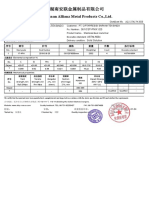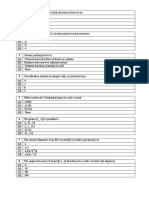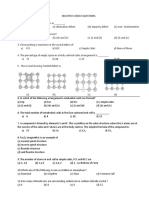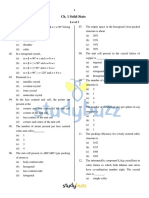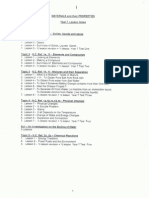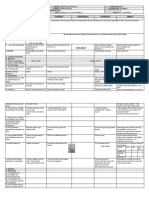Solid State MCQs
Solid State MCQs
Uploaded by
studenthelp360Copyright:
Available Formats
Solid State MCQs
Solid State MCQs
Uploaded by
studenthelp360Copyright
Available Formats
Share this document
Did you find this document useful?
Is this content inappropriate?
Copyright:
Available Formats
Solid State MCQs
Solid State MCQs
Uploaded by
studenthelp360Copyright:
Available Formats
Page 1
Solid State MCQs
1. Which solid structure has a definite and sharp melting point?
a) All types of solids b) No type of solid c) Amorphous solids d) Crystalline solids
2._________ is a crystalline’s basic repetitive structural unit.
a) Monomer b) Molecule c) Unit cell d) Atom
3. Sulfur exists in two polymorphic forms ____________ and ______________
a) rhombic and monoclinic b) rhombic and triclinic
c) hexagonal and triclinic d) hexagonal and monoclinic
4. What is the total number of Bravais lattices in the crystal structures?
a) 3 b) 6 c) 14 d) 24
5. Solid-state is denser than the liquid and gaseous states of the same substance. Which of the following is an
exception to this rule?
a) Mercury b) Carbon dioxide (dry ice) c) Ice d) NaCl
6. Which of the following is an amorphous solid?
a) Quartz b) Quartz glass c) Graphite d) Salt (NaCl)
7. Which of the following statements is true for an amorphous solid?
a) Long range order is present b) Short range order is present
c) There is no orderly arrangement d) Complete order is present at lower temperatures
8. In polar molecular solids, the molecules are held together by
a) dipole-dipole interactions b) dispersion forces
c) hydrogen bonds d) covalent bonds
9. Diamond is an example of
a) solid with hydrogen bonding b) electrovalent solid c) covalent solid d) glass
10. Silicon is found in nature in the forms of
a) bcc b) hcp c) network solid d) fcc
11. Which one of the following are the dimensions of cubic crystal?
a) a =b ≠ c b) a = b = c and α = β ≠ γ = 90
c) a = b = c and α = β = γ = 90 d) a ≠ b = c and α = β ≠ γ = 90
12. Which of the following is not a crystal system?
a) Cubic b) Trigonal c) Triclinic d) Hexaclinic
13. In face-centred cubic cell, a unit cell is shared equally by
a) four unit cells b) two unit cells c) one unit cell d) six unit cells
14. The unit cell with a≠b≠c and α=β=γ=90 refers to __________ crystal system.
a) hexagonal b) trigonal c) triclinic d) orthorhombic
15. Which is the most unsymmetrical crystal system?
a) Triclinic crystal system b) Cubic crystal system
c) Hexagonal crystal system d) Trigonal crystal system
Page 2
16. In the simple cubic cell, each corner atom is shared by
a) eight unit cells b) one unit cell c) two unit cells d) six unit cells
17. The points which shows the position of atoms in crystal are called as _________
a) crystal lattice b) crystal parameters c) bravais lattice d) lattice point
18. The unit cell with a≠b≠c and α=γ=90, β≠90 refers to __________crystal system.
a) cubic b) tetragonal c) monoclinic d) triclinic
19. Which type of solid crystals will conduct heat and electricity?
a) Ionic b) Covalent c) Molecular d) Metallic
20. Which of the following is a characteristic of amorphous solid?
a) They are true solids b) They have sharp melting points
c) They undergo clear cleavage d) They are isotropic
21. 17. Solid carbon dioxide is an example of _________
a) metallic crystal b) covalent crystal c) ionic crystal d) molecular crystal
22. Polar molecular solids are _________
a) bad conductors of electricity b) good conductors of electricity
c) solid at room temperature d) brittle
23. Which of the following tend to be volatile liquids to soft solids at room temperature and pressure?
a) Non polar molecular solids b) Metallic solids
c) Polar molecular solids d) Hydrogen bonded molecular solids
25. Which type of solids are formed by three-dimensional arrangement of cations and anions bound by strong
electrostatic force?
a) Polar molecular solids b) Ionic solids c) Covalent solids d) Metallic solids
26. Which of the following is non-conductor of electricity at solid state but can conduct electricity in the molten
state or when dissolved in water?
a) Non polar molecular solids b) Metallic solids c) Ionic d) Hydrogen bonded molecular solids
27. Which of the following are responsible for high electrical and thermal conductivity of a metal?
a) Ions b) Covalent bonds c) Free H+ ions d) Free and mobile electrons
28. Which type of crystalline solid is also called as giant molecules?
a) Ionic solids b) Covalent solids c) Polar molecular solids d) Metallic solids
29. Which of the following unit cells has constituent particles occupying the corner positions only?
a) Body-centered cell b) Primitive cell c) Face centered cell d) End-centered cell
30. What is the coordination number of a body-centered unit cell?
a) 6 b) 12 c) 8 d) 4
31. Which of the following arrangements of particles does a simple cubic lattice follow?
a) ABAB b) AABB c) ABCABC d) AAA
32. Which of the following arrangements of particles does a hcp follow?
a) ABAB b) AABB c) ABCABC d) AAA
Page 3
33. Which of the following arrangements of particles does a ccp follow?
a) ABAB b) AABB c) ABCABC d) AAA
34. If a crystal lattice has 6 closed-pack spheres, what the number of tetrahedral voids in the lattice?
a) 12 b) 6 c) 36 d) 3
35. If a crystal lattice has 6 closed-pack spheres, what the number of octahedral voids in the lattice?
a) 12 b) 6 c) 36 d) 3
36. A compound is formed by atoms of elements A occupying the corners of the unit cell and an atom of element
B present at the center of the unit cell. Deduce the formula of the compound.
a) AB2 b) AB3 c) AB4 d) AB
37. A compound is formed by atoms of elements A occupying the corners of the unit cell and an atom of element
B present at the face of the unit cell. Deduce the formula of the compound.
a) AB2 b) AB3 c) AB4 d) AB
38. Atoms of element X form a BCC and atoms of element Y occupy 3/4th of the tetrahedral voids. What is the
formula of the compound?
a) X2Y3 b) X3Y2 c) X3Y4 d) X4Y3
39. What is the total volume of the particles present in a body centered unit cell?
a) 8πr3 b) πr3 c) πr3 d) πr3
40. If the aluminum unit cell exhibits face-centered behavior then how many unit cells are present in 54g of
aluminum?
a) 1.2042 x 1024 b) 5.575 x 1021 c) 3.011 x 1023 d) 2.4088 x 1024
41. What is the radius of a metal atom if it crystallizes with body-centered lattice having a unit cell edge of 333
Pico meter?
a) 1538.06 pm b) 769.03 pm c) 288.38 pm d) 144.19 pm
42. The total number of atoms in one unit cell of primitive(scc), FCC & BCC unit cubic cell is ______ atom(s).
a) 1, 4 & 2 b) 8, 4 & 2 c) 4, 8 & 2 d) 2, 4 & 1
43. What is the coordination number for one-dimensional close packing?
a) 2 b) 1 c) 4 d) 6
44. What is the coordination number for a two-dimensional square close packed structure?
a) 8 b) 4 c) 6 d) 2
45. What is the coordination number for a two-dimensional hexagonal close packed structure?
a) 4 b) 8 c) 12 d) 6
46. What is the coordination number for a two-dimensional 3D cubic close packed structure?
a) 4 b) 8 c) 12 d) 6
47. What does the ratio ‘space occupied/total space’ denote?
a) Packing factor b) Packing efficiency c) Particle fraction d) Packing unit
Page 4
48. Arrange the types of arrangement in terms of decreasing packing efficiency.
a) BCC < Simple cubic < CCP b) HCP < CCP < BCC c) HCP < BCC < Simple cubic d) CCP < BCC < HCP
49. What are the percentages of free space in a CCP/FCC and simple cubic lattice?
a) 52% and 74% b) 48% and 26% c) 26% and 48% d) 74%
and 52%
50. How many atoms surround the central atom present in a unit cell with the least free space available?
a) 4 b) 6 c) 8 d) 12
51. An element with cell edge of 288 pm has a density of 7.2 g cm-3. What type of structure does the element
have if it’s atomic mass M=51.8 g mol-1?
a) (BCC) b) (FCC) c) (SCC) d) (HCP)
52. In which type of point defect are the cations and anions absent in stoichiometric proportions?
a) Schottky defect b) Frenkel defect c) Impurity defect d) does not occur for any point defect.
53. Schottky defects are observed in solids with cations and anions of similar sizes. Which of the following
compounds, therefore, is NOT likely to have a Schottky defect?
a) NaCl/KCI/CsCI/KBr/AgBr b) AgCl/AgI/ZnS c) ZnO/FeO d) Fe(s)
54. Stainless steel is a/an ________ alloy.
a) vacant b) interstitial c) substitution d) pure
55. NaCl crystals appear yellow due to:
(a) Schottky defect (b) F – centres (c) Frenkel defect d) Interstitials
56. Two ions X+ and Y- have the ionic radius 88 pm and 200 pm respectively. In the close packed crystal of
compound XY, predict the coordination number of X+.
A)4 B) 8 C)6 D)3
57. A solid has a bcc structure. If the distance of closest approach between the two atoms is 1.73 Å, then the
edge length of the cell is:
1. 200 pm 2. 32 pm 3. 142.2 pm 4. 2 pm
58. The ratio of cations to anion in a closed pack tetrahedral is:
1. 0.714 2. 0.225 3. 0.02 4. none of these
59. Oxygen atoms form fcc unit cells with 'A' atoms occupying all tetrahedral voids and 'B' atoms occupying all
octahedral voids. If atoms are removed from two of the body diagonals then the formula of the resultant
compound formed is:
1. A4B4O7 2. A8B6O7 3. A8B8O7 4. A6B8O6
60. The appearance of color in solid alkali metal halides is generally due to:-
1. Frenkel Defect 2. Interstitial Defect 3. F-Centres 4. Schottky Defect
61. In a face centred cubic lattice, atom A occupies the corner positions and atom B occupies the face
centre positions. If one atom of B is missing from one of the face centred points, the formula of the compound is
1.AB2 2.A2B3 3.A2B5 4.A2B
62. The edge length of fcc unit cell of NaCl is 508 pm. If the radius of cation is 110 pm, then the radius of the
anion is :
1. 144 pm 2. 249 pm 3. 288 pm 4. 398 pm
You might also like
- 1.longhorn Secondary ChemistryDocument241 pages1.longhorn Secondary ChemistryKevon KbulimoNo ratings yet
- Solid State Mcqs Chemistry For Mht-CetDocument4 pagesSolid State Mcqs Chemistry For Mht-Cetsahil100% (1)
- MTC 17 4PH Al20201127a174Document1 pageMTC 17 4PH Al20201127a174Ajeng PratiwiNo ratings yet
- Physical Chemistry MCQS Question BankDocument5 pagesPhysical Chemistry MCQS Question BankMUHAMMAD JUNAID33% (3)
- Academic Year 2020 - 2021 - ODD Semester PH8151 - Engineering Physics Unit-V Crystal PhysicsDocument10 pagesAcademic Year 2020 - 2021 - ODD Semester PH8151 - Engineering Physics Unit-V Crystal PhysicsBala NandaNo ratings yet
- Crystal StructureDocument16 pagesCrystal StructureᎽᎪsh ᏒᎪj sᎥᏁᎶhNo ratings yet
- H.W XiiDocument10 pagesH.W XiiNavneel DuttaNo ratings yet
- Gold Questions: Solid State ChemistryDocument7 pagesGold Questions: Solid State Chemistryabhishek pathakNo ratings yet
- 12 Chem SolidmcqDocument4 pages12 Chem SolidmcqJohnson PackiyarajNo ratings yet
- Yrk Mohan 2ND Puc Chemistry 2023 Model QuestionsDocument5 pagesYrk Mohan 2ND Puc Chemistry 2023 Model QuestionsNaga Raj S100% (1)
- Quiz 1 MED 201Document4 pagesQuiz 1 MED 201Himanshu PathakNo ratings yet
- 12 Chem SolidDocument28 pages12 Chem SolidJohnson PackiyarajNo ratings yet
- 421873-1711527422199-Solid State CCP SHEET 1Document11 pages421873-1711527422199-Solid State CCP SHEET 1saxenasarvesh9No ratings yet
- Solid State Final by Pragya 07.10.10Document16 pagesSolid State Final by Pragya 07.10.10kumarm78No ratings yet
- 1stl Term Exam 18-1-2011docDocument5 pages1stl Term Exam 18-1-2011docLobna Sharaf El DeenNo ratings yet
- 5th Year Exit Exam Tutorial Questions-1Document25 pages5th Year Exit Exam Tutorial Questions-1gudinadewaNo ratings yet
- LO12 Solid State Physics: A) 144 PM B) 204 PM C) 288 PM D) 408 PMDocument4 pagesLO12 Solid State Physics: A) 144 PM B) 204 PM C) 288 PM D) 408 PMpewNo ratings yet
- Unit 1Document7 pagesUnit 1PrasanthNo ratings yet
- M.Sc. Physics University Department MS 403 - Characterization of MaterialsDocument15 pagesM.Sc. Physics University Department MS 403 - Characterization of MaterialsFast FeneNo ratings yet
- Solid State MCQ & CsaDocument10 pagesSolid State MCQ & Csashivansh upadhyay100% (1)
- Solid StateDocument1 pageSolid Statekashvikalra613No ratings yet
- Solid State Revision SheetDocument6 pagesSolid State Revision SheetRumaysa -No ratings yet
- Cet Paper-1Document6 pagesCet Paper-1smalhaar111No ratings yet
- Introduction To Solid State IITDocument22 pagesIntroduction To Solid State IITchaitramallu100% (1)
- 2024 - Materials Science - Test 1 - Type CDocument12 pages2024 - Materials Science - Test 1 - Type Casteriahituwa205No ratings yet
- Bhel School, Ranipet - 632406 Class Xii-Chemistry (Test-1 Solid State)Document4 pagesBhel School, Ranipet - 632406 Class Xii-Chemistry (Test-1 Solid State)TNo ratings yet
- The Solid State WorkbookDocument31 pagesThe Solid State WorkbookledrapotriNo ratings yet
- Objective Type Questions For Material ScienceDocument44 pagesObjective Type Questions For Material Sciencepiyush138090No ratings yet
- Objectives - I Solid State 1Document4 pagesObjectives - I Solid State 1Sridip BasuNo ratings yet
- Solid State: Objective Type Questions Multiple Choice QuestionsDocument5 pagesSolid State: Objective Type Questions Multiple Choice QuestionsSnehashis BoseNo ratings yet
- Solid State 60 MCQsDocument62 pagesSolid State 60 MCQsDark MysteryNo ratings yet
- The Solid State Class 12 MCQs Questions With AnswersDocument19 pagesThe Solid State Class 12 MCQs Questions With AnswersRohit Chavariya100% (1)
- Lecture 22 (L.O 12 Solid State Questions)Document6 pagesLecture 22 (L.O 12 Solid State Questions)Aya GamalNo ratings yet
- Theoretical Questions Revision 1 Solid State Physics 1 Sheet1Document6 pagesTheoretical Questions Revision 1 Solid State Physics 1 Sheet1ريمكس REMIXNo ratings yet
- MCQDocument4 pagesMCQarpitapanda157No ratings yet
- 2018 Basic Sci 22102 Common Ut1 Sem1Document9 pages2018 Basic Sci 22102 Common Ut1 Sem1Swati NavaniNo ratings yet
- Chem Academy: Exercise - IDocument11 pagesChem Academy: Exercise - IHamit RanaNo ratings yet
- Session 1 Post-TestDocument4 pagesSession 1 Post-TestHelen BillonesNo ratings yet
- Chemistry Chapterwise MCQ Book Mht-CetDocument156 pagesChemistry Chapterwise MCQ Book Mht-CetShlok ParekhNo ratings yet
- Solid State (Exercise)Document35 pagesSolid State (Exercise)Vishu PatryNo ratings yet
- Solid State Physics MCQsDocument7 pagesSolid State Physics MCQsAhsan MoinNo ratings yet
- SS 1Document7 pagesSS 1xanshahNo ratings yet
- Namma Kalvi 12th Chemistry Unit 6 Study Material em 218892Document9 pagesNamma Kalvi 12th Chemistry Unit 6 Study Material em 218892o4404118No ratings yet
- NTSE Practice Paper - 11 Scholastic Aptitude Test (Science)Document3 pagesNTSE Practice Paper - 11 Scholastic Aptitude Test (Science)pagalNo ratings yet
- DPP 01 Solid StateDocument14 pagesDPP 01 Solid Stateanupamgupta112No ratings yet
- MCQ & Fib-2023Document26 pagesMCQ & Fib-2023Vishal SNo ratings yet
- Solid State 1Document6 pagesSolid State 1bibhas_samantaNo ratings yet
- PT1 Test Class 12 FinalDocument8 pagesPT1 Test Class 12 FinalAakansha BhandariNo ratings yet
- Roll No 13 Chem Term 1 PaperDocument5 pagesRoll No 13 Chem Term 1 Papershamini sasikumarNo ratings yet
- QP Grade 9 Science Midterm 2023-24Document8 pagesQP Grade 9 Science Midterm 2023-24obungaowoNo ratings yet
- Chemistry: Solid States:: (Cbse Aipmt 2012 A) 2 B) 4 C) 1 D) 3Document2 pagesChemistry: Solid States:: (Cbse Aipmt 2012 A) 2 B) 4 C) 1 D) 3knlsinhaNo ratings yet
- (Xii) Solid State (Assignment)Document10 pages(Xii) Solid State (Assignment)sitaramroyalNo ratings yet
- 2363227Document14 pages2363227loginajmalakNo ratings yet
- 5th Year Exit Exam Tutor Question Chapt 1&2Document6 pages5th Year Exit Exam Tutor Question Chapt 1&2gudinadewaNo ratings yet
- Zeal Study 12th Chemistry UnitDocument26 pagesZeal Study 12th Chemistry UnitYoga YuvethaNo ratings yet
- Ch-1 Solid State Gujcet PyqDocument19 pagesCh-1 Solid State Gujcet PyqWhoaretoNo ratings yet
- Solid States Question PaperDocument1 pageSolid States Question PaperSomu Yashawant ChaudhariNo ratings yet
- 295 4 Solid State Practice ProblemsDocument11 pages295 4 Solid State Practice ProblemsArijit SinghNo ratings yet
- Solid State - (Level I, II &III) - MCQDocument19 pagesSolid State - (Level I, II &III) - MCQ1325-G-Rohan VatturkarNo ratings yet
- Self-Assembling Systems: Theory and SimulationFrom EverandSelf-Assembling Systems: Theory and SimulationLi-Tang YanNo ratings yet
- Jim's KS3 NotesDocument111 pagesJim's KS3 Notesjimbaker007100% (1)
- Particle Nature of MatterDocument87 pagesParticle Nature of MatterDaphnie Serate Nunez100% (1)
- Holiday: GRADES 1 To 12 Daily Lesson LogDocument3 pagesHoliday: GRADES 1 To 12 Daily Lesson LogNelita BeatoNo ratings yet
- PharmacyDocument23 pagesPharmacyXyries Blues IlagaNo ratings yet
- 2-6 Phases of MatterDocument3 pages2-6 Phases of MatterRon Keanu BaronggoNo ratings yet
- Synthesis of Spinel MgFe2O4 FerriteDocument9 pagesSynthesis of Spinel MgFe2O4 FerritewillaimNo ratings yet
- MTD002 - Tore® LanceDocument7 pagesMTD002 - Tore® LanceHani Youssef ArgaliousNo ratings yet
- 22 Metallic Glass: Aggregated Diamond or Hyper DiamondDocument3 pages22 Metallic Glass: Aggregated Diamond or Hyper DiamondMariam AbdulkariamNo ratings yet
- ENS 167 Course Guide (1st Sem 2021-2022)Document6 pagesENS 167 Course Guide (1st Sem 2021-2022)AbdulJabbarLawiNo ratings yet
- Lesson 2 States of MatterDocument4 pagesLesson 2 States of Matterapi-266562995No ratings yet
- Matter 65Document13 pagesMatter 65Venkateswar PatroNo ratings yet
- MTCR Handbook Item5Document11 pagesMTCR Handbook Item5ksvvijNo ratings yet
- 1498 - 1 - Induction Heating SystemDocument1 page1498 - 1 - Induction Heating SystemhaddanNo ratings yet
- Flowmatic Filter CartridgesDocument14 pagesFlowmatic Filter CartridgesasdthuNo ratings yet
- Chemistry PDFDocument21 pagesChemistry PDFPrasann R NamannavarNo ratings yet
- Revision Notes On Solid StateDocument5 pagesRevision Notes On Solid StateAthira VijayNo ratings yet
- UB Glossary - For - ChemistryDocument6 pagesUB Glossary - For - Chemistry龙澄No ratings yet
- Research On ColloidsDocument4 pagesResearch On ColloidsJunyvil TumbagaNo ratings yet
- Preface: (Nadeem Irshad Kayani) Programme Director Directorate of Staff Development, PunjabDocument61 pagesPreface: (Nadeem Irshad Kayani) Programme Director Directorate of Staff Development, Punjabsalman khanNo ratings yet
- 4 - Rotary DryerDocument24 pages4 - Rotary DryerkhawarNo ratings yet
- 2nd Year Chemistry Sc2 ChemistryDocument792 pages2nd Year Chemistry Sc2 Chemistrybiranchi satapathyNo ratings yet
- Year 7 SLGDocument38 pagesYear 7 SLGMeetaDeviNo ratings yet
- تجربة رقم 2 انتقال حرارةDocument11 pagesتجربة رقم 2 انتقال حرارةغيث منعمNo ratings yet
- Coll OidsDocument45 pagesColl OidsGlenda Abogadie PinguelNo ratings yet
- Science DDL Grade 3Document4 pagesScience DDL Grade 3Alera KimNo ratings yet
- Cambridge International As and A Level Chemistry Coursebook - 2 Edition Part2Document108 pagesCambridge International As and A Level Chemistry Coursebook - 2 Edition Part2JaredNo ratings yet
- Physics Notes Class 12 Chapter 14 Semiconductor Electronics, Materials, Devices and Sample CircuitsDocument13 pagesPhysics Notes Class 12 Chapter 14 Semiconductor Electronics, Materials, Devices and Sample CircuitsAisha Agarwal50% (2)
- (L2) - Solid State - 10 Apr 2020Document39 pages(L2) - Solid State - 10 Apr 2020ankitNo ratings yet


